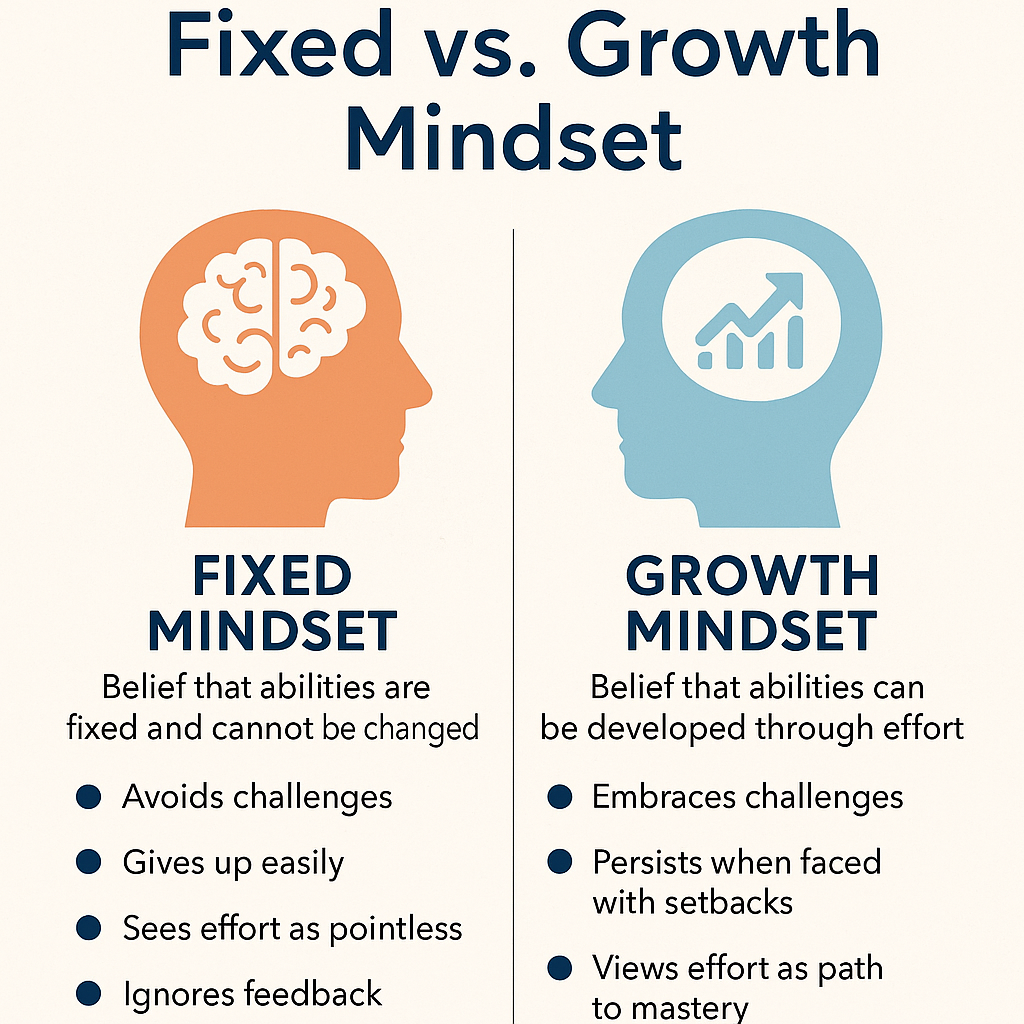Your mindset shapes how you see yourself, your abilities, and the world around you. It determines how you handle challenges, respond to feedback, and pursue goals. And according to psychologist Carol Dweck, there are two primary types of mindset that influence everything: fixed and growth.
Understanding the difference — and learning how to shift from a fixed to a growth mindset — can transform your personal and professional life.
Let’s explore what each mindset looks like and how to develop a mindset that fuels growth, resilience, and success.
What Is a Fixed Mindset?
A fixed mindset is the belief that your intelligence, talents, and abilities are static — you either have them or you don’t. People with a fixed mindset often believe that effort is useless and failure is a reflection of inadequacy.
Common traits of a fixed mindset:
- Avoiding challenges to avoid failure
- Giving up easily when facing obstacles
- Viewing effort as pointless
- Feeling threatened by others’ success
- Taking criticism personally
A fixed mindset leads to a fragile sense of self-worth and can limit your potential. If you believe you can’t improve, you stop trying.
What Is a Growth Mindset?
A growth mindset is the belief that your abilities and intelligence can be developed through effort, learning, and persistence. It’s not about thinking you can do anything immediately — it’s about believing you can improve over time.
Common traits of a growth mindset:
- Embracing challenges as opportunities
- Persisting through setbacks
- Seeing effort as a path to mastery
- Learning from feedback
- Feeling inspired by others’ success
This mindset encourages resilience, learning, and long-term achievement.
Real-Life Examples
Let’s say you get a poor grade on a test or receive negative feedback at work.
- Fixed mindset response: “I’m just not good at this. I’ll never get better.”
- Growth mindset response: “I didn’t do well this time. What can I learn to improve for next time?”
Or you see a colleague succeed in an area where you’re struggling.
- Fixed mindset: “They’re just naturally talented. I’ll never reach that level.”
- Growth mindset: “That’s inspiring. I can learn from what they did.”
Your mindset frames your story — and your story influences your next steps.
Why It Matters: The Impact of Mindset on Your Life
Studies show that mindset affects everything from academic performance to business leadership, athletic performance, and personal relationships.
Benefits of a growth mindset:
- Increased motivation
- Higher achievement
- Stronger problem-solving skills
- Greater creativity and innovation
- Improved mental health and resilience
Mindset is not just a personal development buzzword — it’s a foundational principle supported by neuroscience and psychology.
How to Identify Your Current Mindset
Answer the following questions honestly:
- Do I believe I can improve in areas I struggle with?
- How do I respond to failure or criticism?
- Do I often compare myself to others and feel inferior?
- Do I avoid challenges because I fear I’ll fail?
If you tend toward fixed mindset thinking, don’t worry — the goal isn’t perfection. The first step is awareness.
How to Cultivate a Growth Mindset
Shifting your mindset takes practice, but it’s absolutely possible. Here are some strategies to help:
1. Embrace the Power of “Yet”
Instead of saying “I can’t do this,” say “I can’t do this yet.” That one word opens the door to growth.
2. Replace Self-Criticism With Curiosity
Instead of: “I failed — I’m terrible at this,” try:
- “What didn’t work?”
- “What can I try next time?”
- “What skill do I need to improve?”
This turns failure into feedback.
3. Praise Effort, Not Just Results
If you’re working with others — children, coworkers, even yourself — focus on praising hard work, perseverance, and strategy rather than only outcomes.
Examples:
- “I’m proud of how hard you worked on that.”
- “Your progress is impressive.”
- “It’s great to see how you adapted your approach.”
4. Reframe Challenges as Opportunities
See problems as puzzles, not roadblocks. Each challenge is a chance to stretch your abilities.
Ask:
- “What is this teaching me?”
- “How can I use this experience to grow?”
5. Learn From Mistakes Without Shame
Everyone makes mistakes. The key is learning from them without turning them into personal flaws.
Growth-minded reflection:
- “I misunderstood the concept. Let me review it.”
- “Next time, I’ll try a different strategy.”
- “This mistake helped me clarify what not to do.”
6. Surround Yourself With Growth-Oriented People
The people around you influence your mindset. Spend time with those who value learning, curiosity, and progress. Avoid environments that shame failure or celebrate perfectionism.
7. Track and Celebrate Progress
Keep a journal of lessons learned, setbacks overcome, and small wins. Over time, you’ll build a powerful archive of evidence that growth is always possible.
Final Thought: Your Mindset Is a Choice
You’re not stuck with the mindset you were raised with or currently hold. With awareness and intention, you can choose to see the world — and yourself — in a new way.
A growth mindset doesn’t guarantee instant success. But it guarantees that you will keep learning, improving, and becoming stronger with every step.
So choose growth. Choose resilience. Choose to believe that you can — not immediately, but eventually.
